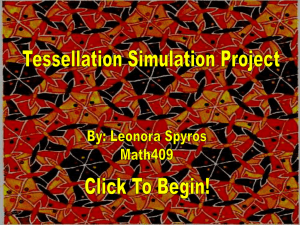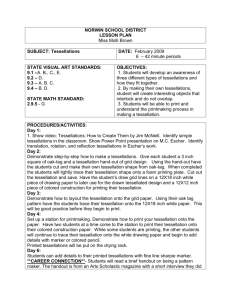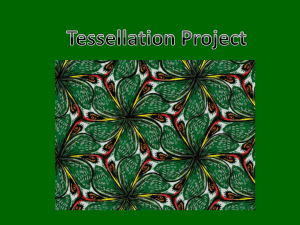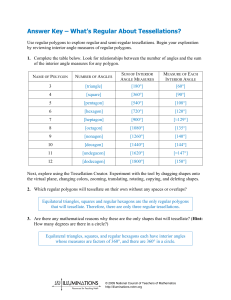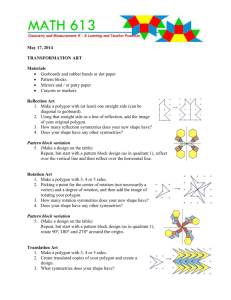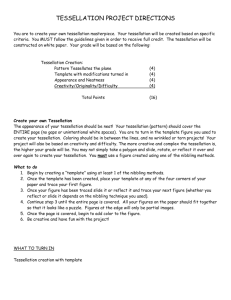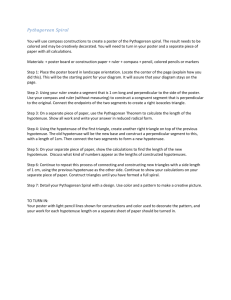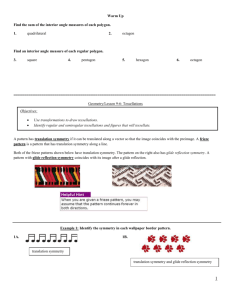Valerie
advertisement
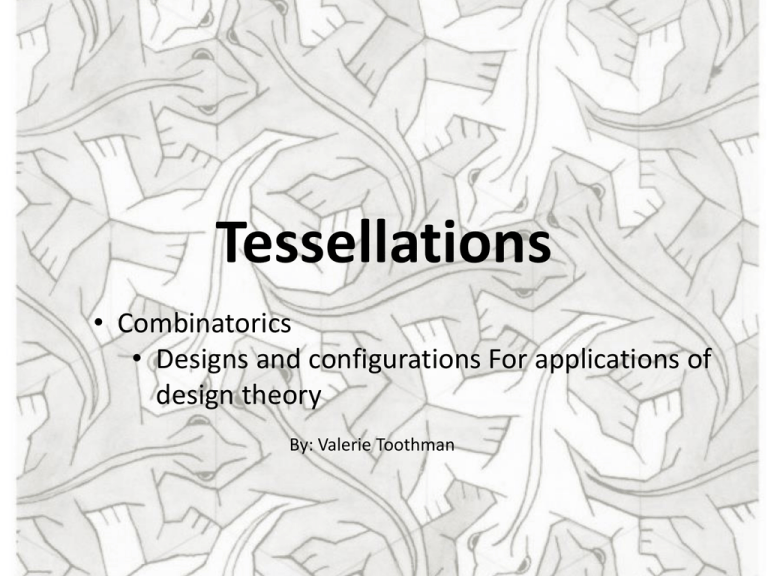
Tessellations
• Combinatorics
• Designs and configurations For applications of
design theory
By: Valerie Toothman
What are Tessellations
• A tessellation is created when a shape is repeated over and
over again covering a plane without any gaps or overlaps.
• Meaning they have to share vertex points (a "corner point“)
and edges (the side of the shape)
• The word "tessellate" is derived from the Ionic version of the
Greek word "tesseres," which in English means "four." The
first tilings were made from square tiles.
Periodic
• Periodic – use tiles that form a repeating
pattern
Regular Tessellation
• A regular tessellation is a tessellation made
up of congruent regular polygons.
– Regular means that the sides and angles of the
polygon are all equivalent (i.e., the polygon is both
equiangular and equilateral).
– Congruent means that the polygons that you put
together are all the same size and shape.]
Regular Tessellation
• There are only 3 regular tessellations:
– Triangle
– Hexagons
-Square
Regular Tessellation
Consider a two-dimensional tessellation with q regular p -gons at each
polygon vertex. In the plane,
1−
2
2𝜋
𝜋=
𝑝
𝑞
1 1 1
+ =
𝑝 𝑞 2
So
𝑝−2 𝑞−2 =4
and the only factorizations are
4 = 4 ∙ 1 = 6 − 2 3 − 2 ⇒ 6,3
= 2 ∙ 2 = 4 − 2 4 − 2 ⇒ 4,4
= 1 ∙ 4 = 3 − 2 6 − 2 ⇒ {3,6}
• When the tessellation is made of regular polygons,
the most common notation is the vertex
configuration, which is simply a list of the number of
sides of the polygons around a vertex
Also called 666 because
at 1 vertex point there
are 3 hexagons with 6
sides
Also called 4444 because Also called 333333 because at 1
vertex point there are 6
at 1 vertex point there
triangles with 3 sides
are 4 squares with 4
sides
Semiregular Tessellation
• A semi-regular tessellation is made of two or
more regular polygons. The pattern at each
vertex must be the same! Sometimes called
Archimedean tessellations. In the plane, there
are eight such tessellations.
Semiregular Tessellation
3.3.3.3.6
3.3.3.4.4
3.3.4.3.4
3.4.6.4
3.6.3.6
3.12.12
4.6.12
4.8.8
Demiregular tessellation
• A demiregular tessellation is a type of tessellation
whose definition is somewhat problematical.
• Some authors define them as orderly
compositions of the three regular and eight
semiregular tessellations (which is not precise
enough to draw any conclusions from), while
others defined them as a tessellation having
more than one transitivity class of vertices (which
leads to an infinite number of possible tilings).
Demiregular tessellation
• There are at least 14 demiregular
tessellations.
• How was this determined? The process is
almost fully trial-and-error and just requires a
lot of time and effort.
Demiregular tessellation
Other Periodic
• Escher
Aperiodic
• Aperiodic - use tiles that cannot form a
repeating pattern
Penrose tiling
• Penrose was not the first to discover aperiodic
tilings, but his is probably the most wellknown. In its simplest form, it consists of 36and 72-degree rhombi, with "matching rules"
forcing the rhombi to line up against each
other only in certain patterns. It can also be
formed by tiles in the shape of "kites" and
"darts"
Penrose tiling
Penrose tiling
• Mathematicians have found no general rule
for determining if a given shape can tile the
plane or not, which means there are many
unsolved problems concerning tessellations.
Sources
• http://mathforum.org/sum95/suzanne/whattess.html
• http://mathworld.wolfram.com/Tessellation.html
• http://www.mathsisfun.com/geometry/tessellation.html

